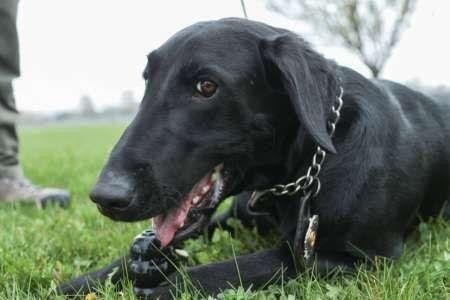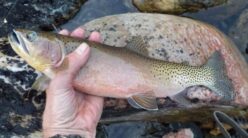IDAHO FALLS — Running around Community Park in Idaho Falls, tail wagging almost as quickly as his feet gallop across the field, Dexter has his nose to the ground as he searches for scent.
He’s a black blur across the green grass, circling around until his sharp nose finds the shotgun casings thrown in the grass by his handler Officer Tim Klucken. Once he’s located the casings, he quickly sits, quivering with excitement.
Klucken hurls a black rubber KONG dog toy toward Dexter, his reward, and he bolts off after it — still a ball of energy after his rapid run. Dexter is a 3-year-old Lab, making him a perfect fit for his line of work.
“You have to have a dog that has that high play drive and high prey drive," Klucken said. "Once they have that, you can teach them to do anything. He’ll do whatever it takes to get his toy.”
Dexter is the Idaho Department of Fish and Game dog for the Upper Snake Region. He joined the department in 2016 as part of its effort to incorporate canines into its enforcement efforts. Dexter is trained in detecting various wildlife, humans, gun oil and gunpowder. But he’s not trained in defense or to attack people, said James Brower, Fish and Game spokesman.
“So a lot of times at check stations where hunters and fishermen are required to stop and show any game they have,” Klucken said, “he’ll tell whether they’re being truthful.”
He’s one of the department’s three dogs scattered across the state. Pepper, a black Lab, kicked-off the effort as part of a pilot program in 2011 as the department’s first dog, working in the Magic Valley Region, Brower said.
Adding Pepper to the force was extremely successful. One of the first cases Pepper worked was to find a missing 2-year-old boy near the Nevada border in 2012. Pepper was able to track the boy nearly a mile and probably saved his life, Klucken said.
Due to the overwhelming success of the pilot program, Dexter and Hudson, a golden Lab, were added to the canine unit in 2016.
The dogs help find evidence that officers couldn’t have on their own, Klucken said. He recalled one case where Dexter was able to find nine shotgun casings for someone who was hunting illegally. Since Dexter was able to find the casings, the officers were able to collect the needed evidence.
Klucken and Dexter often come to Community Park, with its open fields, to train. With all the extra training and care surrounding Dexter, being a canine handler means a lot of work, Klucken said.
“It just requires a lot of time and it changes how I work," Klucken said, "I used to have a four-wheeler in my vehicle and be ready to run up a hill anytime. But with him I can’t necessarily just leave him in the truck depending on the weather.”
Back in the park, Dexter is following the trail of Klucken’s partner, practicing his human scent-tracking abilities. Dexter runs along the perimeter of a baseball field fence, Klucken jogging behind him, following the scent.
Dexter’s canine nose has the ability to pick up not only the human smell, but disturbances in the ground where people have stepped, creating a full scent picture that he can follow.
Soon enough, Dexter finds the scent and sits down — this time getting a rolled up towel for his reward. Each type of collar, leash and toy signify a different type of task for Dexter. He knows that a towel means tracking humans, a KONG means finding gun oil and powder and a blue nylon toy means finding fish and game.
As dogs get older, the better they become, Klucken said. He’s already noticed a difference with Dexter and is looking forward to a long career with him. Labradors have an average life expectancy of 10 to 12 years, but their working years usually depend on the dog.



